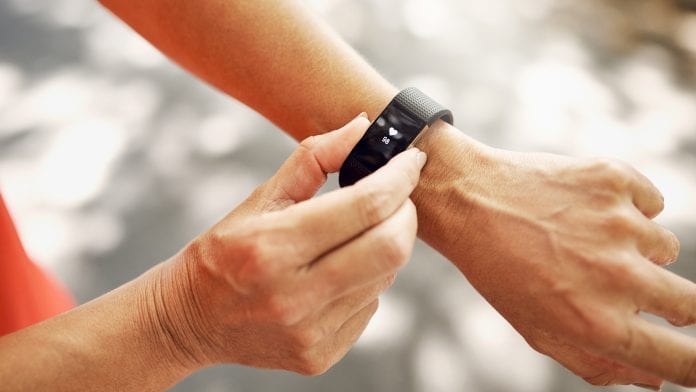
A new study demonstrates the potential of data from wearable devices that measure heart rate to improve surveillance of infectious disease
The research from Scripps Research Translational Institute, published in The Lancet Digital Health, is the first study to evaluate de-identified data from wearable devices on resting heart rate and sleep finds improved real-time prediction of influenza-like illness in 5 US states compared to current surveillance methods.
During infectious episodes, the resting heart rate tends to spike, and this is captured by wearable devices such as smartwatches and fitness trackers, that track heart rate. De-identified data from 47,249 Fitbit users* identifies weeks with elevated resting heart rate and changes to routine sleep. Furthermore, prospective studies will need to be done to help differentiate between infectious versus non-infectious forecasting.
There are over 650,000 deaths worldwide due to influenza. Approximately 7% of working adults and 20% of children aged under the age of five years get the flu each year. Traditional observation reporting takes 1-3 weeks to report, which limits the ability to enact quick outbreak response measures – such as ensuring patients stay at home, wash hands, and the deployment of antivirals and vaccines.
Previous studies using crowdsourced data, such as Google Flu Trends and Twitter have found variable success on their own as these methods tend to overestimate rates during epidemics. This is because it is impossible to separate out the activity of individuals with influenza from heightened awareness or related to media during flu season.
The study author, Dr Jennifer Radin, Scripps Research Translational Institute, USA, says: “Responding more quickly to influenza outbreaks can prevent further spread and infection, and we were curious to see if sensor data could improve real-time surveillance at the state level.
“We demonstrate the potential for metrics from wearable devices to enhance flu surveillance and consequently improve public health responses. In the future as these devices improve, and with access to 24/7 real-time data, it may be possible to identify rates of influenza on a daily instead of a weekly basis.”
Study methodology and findings
The research team analyses de-identified data from 200,000 users who wore a Fitbit wearable device that tracks users’ activity, heart rate and sleep for at least 60 days during the study time from March 2016 to March 2018.
From the 200,000 users, 47,248 users from California, Texas, New York, Illinois and Pennsylvania wore a Fitbit device consistently during the study period, resulting in a total of 13,342,651 daily measurements evaluated. The users were arranged by which state they lived in, and the proportion of users above the threshold each week was calculated. The average Fitbit user was 43 years old and 60% were female.
All the participants average resting heart rate and sleep duration were calculated, as well as deviations to this to help identify when these measures were outside of an individual’s typical range (e.g. using standard deviation). Throughout the study, a user was identified as abnormal if their weekly average resting heart rate was above their overall average (by more than a half or a full standard deviation) and their weekly average sleep was not below their overall average (by more than half a standard deviation). This data was compared to weekly estimates for influenza-like illness rates reported by the U.S. Centers for Disease Control (CDC).
The vast amount of data from the Fitbit trackers meant that influenza predictions at the state level were improved. In all five states, there was an improvement in real-time surveillance, and the closest alignment with CDC data was found when abnormal resting heart rate was defined as half a standard deviation above normal and sleep more than half a standard deviation below.
This is the first of its kind study where heart rate trackers and sleep data have been used to predict flu, or any infectious disease, in real-time and with greater volumes of data, it may be possible to apply the method to more geographically defined areas, such as county or city-level.
However, the researchers have identified several limitations in their study:
- A general lack of activity data meant they could not control for seasonal fitness changes or more short-term activity changes.
- Weekly resting heart rate averages may include days when an individual is both sick and not sick, and this may result in underestimation of illness by lowering the weekly averages.
- There may be other external factors that increase resting heart rate, including stress or other infections.
- The researchers do note that previous studies of sleep measuring devices have been found to have low accuracy, though the authors note that accuracy will continue to improve as technology evolves.
Additionally, the Fitbit users within the study were predominantly middle-aged adults and likely higher income than the general population so potentially less likely to suffer comorbidities which could make them more susceptible to severe infections. They also may be more likely to get influenza vaccines or receive antivirals or other medicines if they do get sick which can reduce disease severity, so the models may need to be modified for use in other populations.
In a linked Comment article, Dr Cécile Viboud, Fogarty International Center, National Institutes of Health, USA, says: “The study by Radin et al is a promising first step towards integrating wearable measurements in predictive models of infectious diseases.
“We anticipate that a large amount of real-time data generated by Fitbit and other personal devices will prove highly useful for public health and augment traditional surveillance systems. The ever-expanding “big data” revolution offers unique opportunities to mine new data streams, identify epidemiologically-relevant patterns, and enrich infectious disease forecasts.”
*All Fitbit users, including those whose data are included in this study, are notified that their de-identified data could potentially be used for research in the Fitbit Privacy Policy.









